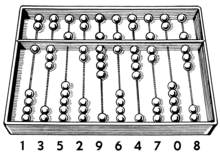
Back Abakus Afrikaans Abaco AN معداد Arabic এবাকাছ Assamese Ábacu AST Jakhuña Aymara Abak Azerbaijani چؤرتکه AZB Abakus BCL Абак Byelorussian

An abacus (pl. abaci or abacuses), also called a counting frame, is a hand-operated calculating tool which was used from ancient times in the ancient Near East, Europe, China, and Russia, until the adoption of the Hindu–Arabic numeral system.[1] An abacus consists of a two-dimensional array of slidable beads (or similar objects). In their earliest designs, the beads could be loose on a flat surface or sliding in grooves. Later the beads were made to slide on rods and built into a frame, allowing faster manipulation.
Each rod typically represents one digit of a multi-digit number laid out using a positional numeral system such as base ten (though some cultures used different numerical bases). Roman and East Asian abacuses use a system resembling bi-quinary coded decimal, with a top deck (containing one or two beads) representing fives and a bottom deck (containing four or five beads) representing ones. Natural numbers are normally used, but some allow simple fractional components (e.g. 1⁄2, 1⁄4, and 1⁄12 in Roman abacus), and a decimal point can be imagined for fixed-point arithmetic.
Any particular abacus design supports multiple methods to perform calculations, including addition, subtraction, multiplication, division, and square and cube roots. The beads are first arranged to represent a number, then are manipulated to perform a mathematical operation with another number, and their final position can be read as the result (or can be used as the starting number for subsequent operations).
In the ancient world, abacuses were a practical calculating tool. Although calculators and computers are commonly used today instead of abacuses, abacuses remain in everyday use in some countries. The abacus has an advantage of not requiring a writing implement and paper (needed for algorism) or an electric power source. Merchants, traders, and clerks in some parts of Eastern Europe, Russia, China, and Africa use abacuses. The abacus remains in common use as a scoring system in non-electronic table games. Others may use an abacus due to visual impairment that prevents the use of a calculator.[1] The abacus is still used to teach the fundamentals of mathematics to children in many countries such as Japan[2] and China.[3]
- ^ a b Boyer & Merzbach 1991, pp. 252–253
- ^ "The Japan Society - Soroban: The Japanese Abacus". www.japansociety.org.uk. Retrieved January 17, 2025.
- ^ Gueudet, Ghislaine; Poisard, Caroline (January 1, 2019). "Design and use of curriculum resources for teachers and teacher educators: Example of the Chinese abacus at primary school". International Journal of Educational Research. 93: 68–78. doi:10.1016/j.ijer.2018.10.007. ISSN 0883-0355.